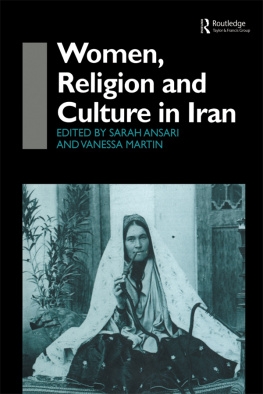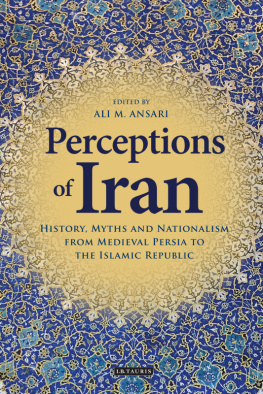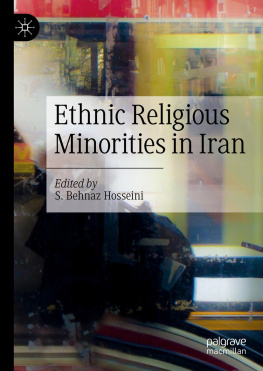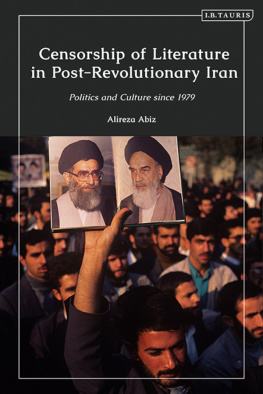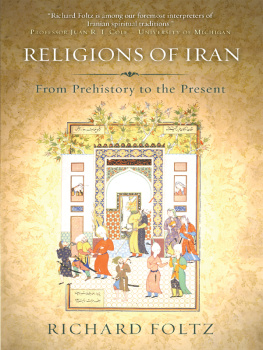Sarah Ansari - Women, Religion and Culture in Iran
Here you can read online Sarah Ansari - Women, Religion and Culture in Iran full text of the book (entire story) in english for free. Download pdf and epub, get meaning, cover and reviews about this ebook. year: 2001, publisher: Routledge, genre: Religion. Description of the work, (preface) as well as reviews are available. Best literature library LitArk.com created for fans of good reading and offers a wide selection of genres:
Romance novel
Science fiction
Adventure
Detective
Science
History
Home and family
Prose
Art
Politics
Computer
Non-fiction
Religion
Business
Children
Humor
Choose a favorite category and find really read worthwhile books. Enjoy immersion in the world of imagination, feel the emotions of the characters or learn something new for yourself, make an fascinating discovery.
- Book:Women, Religion and Culture in Iran
- Author:
- Publisher:Routledge
- Genre:
- Year:2001
- Rating:3 / 5
- Favourites:Add to favourites
- Your mark:
- 60
- 1
- 2
- 3
- 4
- 5
Women, Religion and Culture in Iran: summary, description and annotation
We offer to read an annotation, description, summary or preface (depends on what the author of the book "Women, Religion and Culture in Iran" wrote himself). If you haven't found the necessary information about the book — write in the comments, we will try to find it.
Women, Religion and Culture in Iran — read online for free the complete book (whole text) full work
Below is the text of the book, divided by pages. System saving the place of the last page read, allows you to conveniently read the book "Women, Religion and Culture in Iran" online for free, without having to search again every time where you left off. Put a bookmark, and you can go to the page where you finished reading at any time.
Font size:
Interval:
Bookmark:
Women, Religion and Culture in Iran

Royal Asiatic Society Books
The Royal Asiatic Society was founded in 1823 for the investigation of subjects connected with, and for the encouragement of science, literature and the arts in relation to, Asia. Informed by these goals, the policy of the Societys Educational Board is to make available in appropriate formats the results of original research in the humanities and social sciences having to do with Asia, defined in the broadest geographical and cultural sense and up to the present day.
The Man in the Panthers Skin
Shota Rustaveli
Translated from the Georgian by M. S. Wardrop
Women, Religion and Culture in Iran
Edited by
Sarah Ansari and Vanessa Martin

First Published in 2002
by Routledge
2 Park Square, Milton Park, Abingdon, Oxon, OX14 4RN
711 Third Avenue, New York, NY 10017
First issued in paperback 2011
2002 Sarah Ansari and Vanessa Martin
Typeset in Minion by LaserScript Ltd, Mitcham, Surrey
All rights reserved. No part of this book may be reprinted or reproduced or utilised in any form or by any electronic, mechanical, or other means, now known or hereafter invented, including photocopying and recording, or in any information storage or retrieval system, without permission in writing from the publishers.
British Library Cataloguing in Publication Data
A catalogue record of this book is available from the British Library
Library of Congress Cataloguing in Publication Data
A catalogue record for this book has been requested
Publishers Note
The publisher has gone to great lengths to ensure the quality of this reprint but points out that some imperfections in the original may be apparent
ISBN13: 978-0-700-71509-1 (hbk)
ISBN13: 978-0-415-51531-3 (pbk)
Contents
The Editors gratefully acknowledge the support of the British Academy, the Royal Asiatic Society, and the History Department, Royal Holloway, University of London.
It is undeniable that, over the course of the twentieth century and in many parts of the world, women and issues connected with them have steadily moved centre stage much more publicly than had been the case in earlier times. Gender, of course, has always been crucial in the shaping of social, economic and political relations, but now any pretence that this has ever been otherwise has been stripped away to allow a much clearer view of the ways in which gender and society interact. Misperceptions persist, however, particularly concerning women living in Muslim societies. As often as not, the dominant image of a typical Muslim woman combines powerlessness and passivity on an individual level with what seems like a fierce and active loyalty to her community and its shared values, especially religion and culture. That certain groups of Muslim women have always had access to power by virtue of kinship or marriage connections confounds traditional, often western, ideas about divisions separating the so-called public and private spheres in Muslim societies and the distribution of effective influence between them.have arguably represented a distinct period when it comes to the changing status of women in societies such as Iran.
In Iran, as elsewhere, the reality is that religion has been a source of power for women, or a source of subordination, or both.
This volume of articles, encompassing differences in approach and methodology on the part of their authors, investigates the inter-relationship between women, religion and culture in Iran in both the shorter and the longer term, and underlines the value of interdisciplinary thinking and exchange. The liveliness of the contributions on these themes (which also include writing, education and beliefs), together with their imaginative grasp of the diverse possibilities involved in studying Iranian women, highlights the way in which the discussion on womens roles has been expanding. Thus, the collection reflects a broader shift in contemporary approaches to scholarship that allows a wider range of voices than ever to make themselves heard.
In many ways, the study of Iranian women has begun to enter its mature phase. While, for instance, there is still enormous interest in the impact and aftermath of the 1979 Islamic revolution on the experiences of Iranian women, there is also much healthy concern to develop a better appreciation of how these particular, relatively recent, developments can be fitted into longer cycles of change. Parvin Paidars Women and the Political Process in Twentieth Century Iran reflects this. Building on the earlier work produced by scholars such as Janet Afary, Joanna de Groot and (in relation to more contemporary developments) Valentine Moghadam, Paidar examines in panoramic fashion the role of women in the Iranian political process, a role which she emphasizes has not been passive and marginalized but active and central to political change over the last one hundred years.
Two dominant themes which connect many of the articles in this collection are the role of religion, and Shii Islam in particular, in Iranian society, and the influence of the state. These represent essential strands of influence which have interacted with each other to varying degrees to shape a specifically Iranian culture and identity. The relationship between women and society in Iran has been profoundly affected by these interactions and the contest for power that has often accompanied them. For much of the last century, from the late Qajar period, through the years of Pahlavi dominance, and since the Islamic revolution, representatives of religion and the state have competed with each other to secure their own visions of Iranian society. In the process of this struggle to configure Iranian identity, matters involving women have been drawn into the heart of debates and policy changes by advocates and critics of reform alike.
The centrality of Shii Islam to the character of Iranian culture and social life is explored by Shireen Mahdavi in her article Women, Shiism and Cuisine in Iran which investigates connections between the evolution of Persian cooking from the time of the Safavid period onwards, and the position of women within Persian/Iranian society. Employing an innovative long-term perspective on this issue, Mahdavi is able to place the developments under scrutiny within a framework of trends that have taken place, not just over decades, but over centuries. Mahdavis main focus is on the way in which the cultural norms established by religious belief and practice affect crucial day-to-day aspects of the lives of certain kinds of elite Iranian women, but she also highlights the importance of the nature of the state under the Safavids, and later the Qajars, in helping to establish conditions which favoured the emergence of an elaborate and highly specialized cuisine.
In the late nineteenth century, Iranian women by all accounts lived largely secluded lives. Iran, however, was not isolated from political developments taking place outside its borders, and had been drawn increasingly into the contest between imperial powers for supremacy within the region. As a result,
Christian missionaries in Iran, not surprisingly perhaps, were included among those who participated in this debate. As Gulnar Francis-Dehqani underlines in her CMS Women Missionaries in Iran, 18911934: Attitudes towards Islam and Muslim Women, seeking to reform what they perceived as the pitiable status of Iranian women provided much of the raison dtre for British women who came out to Iran to work as missionaries, even when the impetus for their mission was complicated, and had more to do with social developments back home than what was taking place abroad. Much the same could be said for American missionaries working in Iran during the same period. Michael Zirinsky, in A Presbyterian Vocation to Reform Gender Relations in Iran: the Career of Annie Stocking Boyce, explores how far the social agenda brought with these missionaries translated into the actual experiences and initiatives of one individual missionary. Boyce served in Iran from 1906 to 1941, and during that time worked as hard to encourage Iranian women to become more American in life-style as she did to convert them, in contrast to the British missionaries, who, according to Dehqani, sought to Christianize rather than westernize Iranian society. In the regular reports written by Boyce, it is also possible to trace, albeit through the eyes of an outsider, the extent to which the state under Reza Shah Pahlavi sought to control the way in which Iranian womanhood developed, attempting to fashion the kind of female individual who could reinforce Irans claims to be a modern society as well as retain the cultural and moral independence which Iran was seeking for itself during the interwar years.
Next pageFont size:
Interval:
Bookmark:
Similar books «Women, Religion and Culture in Iran»
Look at similar books to Women, Religion and Culture in Iran. We have selected literature similar in name and meaning in the hope of providing readers with more options to find new, interesting, not yet read works.
Discussion, reviews of the book Women, Religion and Culture in Iran and just readers' own opinions. Leave your comments, write what you think about the work, its meaning or the main characters. Specify what exactly you liked and what you didn't like, and why you think so.

